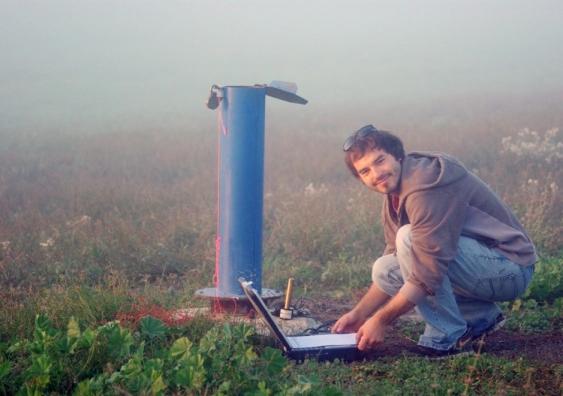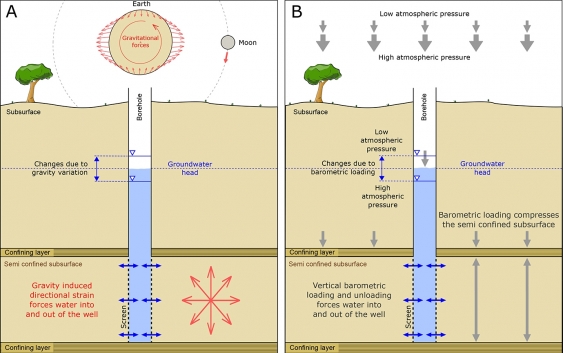Posted 10 May 2019

UNSW Sydney water engineers have revealed that investigating and managing groundwater resources more sustainably can be achieved at lower cost by using existing Earth and atmospheric tidal data.
Groundwater exploration can be achieved at much lower cost and with less invasive procedures thanks to a new passive technique being championed by UNSW engineers.
In an article to be published in Reviews of Geophysics, the research team from UNSW Sydney, Karlsruhe Institute of Technology (KIT) and Deakin University point to a new way of investigating groundwater resources by analysing the groundwater level changes due to influences by Earth and atmospheric tides. These effects can be measured in monitoring boreholes globally.
Dr Gabriel Rau who is an engineering geologist at KIT and affiliated with UNSW’s Connected Waters Initiative Research Centre says that current testing methods require active pumping of water from a specially designed water-extraction well while observing the water level response in other wells in the vicinity.
“This costs a lot of money and only gives a result for that particular location,” he says.
“The properties of groundwater reservoirs – also known as aquifers – vary greatly in space, and it is much too expensive and intrusive to build extraction wells everywhere.
“The new method, on the other hand, involves using tidal information embedded in water levels from monitoring boreholes. It is a passive technique and simpler to conduct than the current practices of pump and aquifer testing.”

Co-author Timothy McMillan – from the UNSW Connected Waters Initiative Research Centre and School of Minerals and Energy Resources Engineering – says the article pulls together studies from multiple disciplines including some previously carried out by UNSW researchers about an underutilised groundwater investigation method.
“Our work has uncovered that recent advancements in this field, developed both here at UNSW and abroad reveal a potential for significantly cheaper long-term groundwater investigations,” he says.
“This method has the advantage of being able to calculate the physical properties of the subsurface from just the measured water levels.”
The engineers say that normally to calculate the groundwater available, a large hole needs to be drilled which then requires a crew of two to three people managing the drill rig to pump water out, anywhere from a few days to several months.
However, as McMillan explains, the passive approach that they recommend requires only a small hole to be drilled, then an automated water pressure data logger to be placed in the hole for a month, which produces the same results.
“An added advantage of our new approach lies in the fact that we can re-analyse decades of existing water level data to calculate subsurface properties that change over time,” he says.
“Whereas the pumping method would require the pumping crew to come back and pump the hole again for the same length of time they previously did to get one more value.”

Dr Rau describes the passive method as “paradigm shifting” in subsurface resources research.
“We can use the impact of Earth and atmospheric tides on commonly acquired atmospheric and groundwater pressure to obtain unprecedented knowledge of subsurface properties at low cost,” he says.
“Similar to tides in the ocean, the groundwater level is affected by tidal forces squeezing the porous rocks in the subsurface and causing measurable pressure changes.”
Another benefit to the cost-saving aspect of the passive approach is the capability to rapidly expand our knowledge of subsurface properties in order to sustainably manage groundwater resources. Groundwater extraction is increasing rapidly throughout the world and is linked to falling water tables, ground surface subsidence, water quality degradation and reduction of stream baseflow.
The engineers say that using a combination of knowledge gained from engineering, science and maths, the impact of Earth and atmospheric tides on groundwater can be used to make calculations to forecast groundwater resources linked to climate variability.
“Our new approach lets us use existing data to get to the same properties [as active exploration],” Dr Rau says.
“And because we can also use the cheaper monitoring boreholes, we get many more locations in space. Also, we can now monitor changes in properties over time.”
The new approach highlights the huge value of existing groundwater monitoring networks, such as those funded by the Australian Government’s National Collaborative Research Infrastructure Strategy.
“We are facing immense challenges related to water resources in the future,” Dr Rau says.
“With the results, we can better manage subsurface resources and do it much more sustainably.”
Associate Professor Martin Andersen who is director of the Connected Waters Initiative and a co-author on the paper says that “if the groundwater industry adopts our suggested investigation technique we will take a giant step forward in the characterisation of the water bearing layers in the subsurface and vastly improve our ability to manage this valuable resource”.
Original article by Lachlan Gilbert was posted on UNSW News Room on 10 May 2019

Professor Andy Baker features in American Water Resources Association ‘Water Resources Impact’, September 2020 edition.

The Connected Waters Initiative (CWI) is pleased to welcome Taylor Coyne to its network as a postgraduate researcher. If you’re engaged in research at a postgraduate level, and you’re interested in joining the CWI network, get in touch! The CWI network includes multidisciplinary researchers across the Schools of Engineering, Sciences, Humanities and Languages and Law.

The Grand Challenge on Rapid Urbanisation will establish Think Deep Australia, led by Dr Marilu Melo Zurita, to explore how we can use our urban underground spaces for community benefit.

On the 21 August 2020, CWI researchers made a submission to the National Water Reform Inquiry, identifying priority areas and making a number of recommendations as to how to achieve a sustainable groundwater future for Australia.

Results published from a research project between the Land Development Department (LDD) Thailand and UNSW has demonstrated how 2-dimensional mapping can be used to understand soil salinity adjacent to a earthen canal in north east Thailand (Khongnawang et al. 2020).